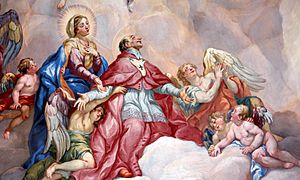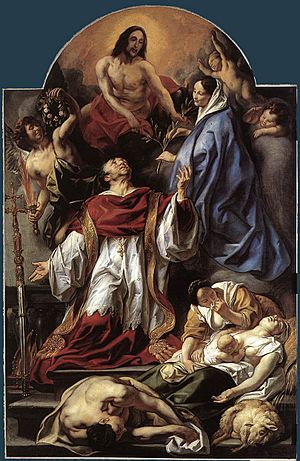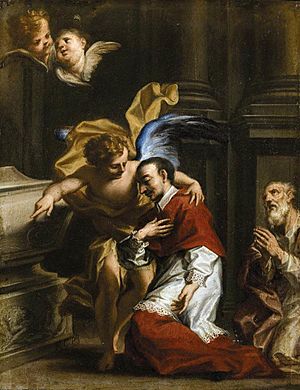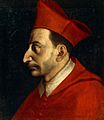Charles Borromeo facts for kids
Quick facts for kids SaintCharles Borromeo |
|
|---|---|
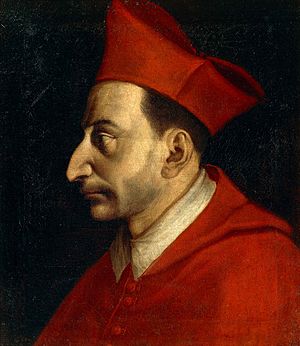
Portrait by Giovanni Ambrogio Figino
|
|
| Bishop and Confessor | |
| Born | 2 October 1538 Castle of Arona, Duchy of Milan |
| Died | 3 November 1584 (aged 46) Milan |
| Beatified | 12 May 1602 by Clement VIII |
| Canonized | 1 November 1610 by Paul V |
| Feast | 4 November |
| Attributes | cord, red cardinal robes |
| Patronage | against ulcers; apple orchards; bishops; catechists; catechumens; colic; intestinal disorders; Lombardy, Italy; Monterey California; cardinals; seminarians; spiritual directors; spiritual leaders; starch makers; stomach diseases; São Carlos city in Brazil (namesake) |
| His Eminence Saint Charles Borromeo | |
|---|---|
| Cardinal Archbishop of Milan |
|
| Native name | Count Carlo Borromeo di Arona |
| Archdiocese | Milan |
| See | Milan |
| Appointed | 12 May 1564 |
| Reign ended | 3 November 1584 |
| Predecessor | Filippo Archinto |
| Successor | Gaspare Visconti |
| Other posts | Cardinal-Priest of Santa Prassede |
| Orders | |
| Ordination | 4 September 1563 |
| Consecration | 7 December 1563 by Giovanni Serbelloni |
| Created Cardinal | 31 January 1560 |
| Rank | Cardinal-Priest |
Charles Borromeo (born 2 October 1538 – died 3 November 1584) was an important leader in the Catholic Church. He served as the Archbishop of Milan from 1564 to 1584. He was also a cardinal.
Charles Borromeo played a big part in the Counter-Reformation. This was the Catholic Church's effort to make changes and strengthen itself after the Protestant Reformation. He worked with other famous figures like Ignatius of Loyola. He helped make important reforms in the Church, including starting schools for priests called seminaries. The Catholic Church honors him as a saint, and his special day is 4 November.
Contents
Early Life and Education
Charles Borromeo came from a very old and rich family in Lombardy, Italy. His family, the Borromeo family, was known for having many important people in both the church and government. Their family symbol even included the Borromean rings.
Charles was born on 2 October 1538, in the castle of Arona. This castle was near Lake Maggiore, about 36 miles from Milan. His father, Gilbert, was the Count of Arona. His mother, Margaret, was from the famous House of Medici family in Milan. Charles was the second of six children.
When he was about twelve, Charles began his church training. His uncle gave him money from a rich church abbey. Charles told his father that any money from the abbey that he didn't need for his church career should go to the poor.
He went to the University of Pavia to study law. People thought he was a bit slow because he had a slight speech problem. But he worked very hard and learned quickly. In 1554, his father died. Even though he had an older brother, Charles was asked to help manage the family's business. He later went back to his studies. On 6 December 1559, he earned his law degree.
Time in Rome
On 25 December 1559, Charles's uncle, Giovanni Angelo Medici, became Pope Pius IV. The new Pope asked Charles to come to Rome. On 13 January 1560, he gave Charles an important church job. Soon after, on 31 January 1560, the Pope made him a cardinal. This meant Charles was in charge of important church documents and helped govern the Papal States. He also oversaw groups like the Franciscans and Carmelites.
During his four years in Rome, Charles lived a simple life. He made church officials wear black robes. He also started an academy for learned people, where they shared their ideas.
Charles helped organize the third and final meeting of the Council of Trent from 1562 to 1563. This council was very important for the Catholic Church. He also played a big part in creating the Tridentine Catechism, which is a book explaining Catholic beliefs. In 1561, Charles founded a college in Pavia, which is still known today as Almo Collegio Borromeo.
In 1562, his older brother, Federico, died suddenly. His family wanted Charles to leave the church and get married to continue the family name. But Charles decided to stay in the church. His brother's death and his connections with groups like the Jesuits made him want to live a stricter Christian life. He decided to fully take on the duties of a bishop, as outlined by the Council of Trent.
Archbishop of Milan
Charles Borromeo was put in charge of the Archdiocese of Milan on 7 February 1560. After deciding to fully embrace his role as a bishop, he became a priest on 4 September 1563. Then, on 7 December 1563, he became a bishop in the Sistine Chapel.
He was officially named archbishop of Milan on 12 May 1564. The Pope allowed him to leave Rome a year later. Charles arrived in Milan as archbishop on 23 September 1565.
Reforming Milan
When Charles arrived in Milan, the archdiocese needed many changes. Previous archbishops had been away for 80 years, and things had become disorganized. Milan was the largest archdiocese in Italy. It had over 3,000 clergy (church leaders) and 800,000 people. Many clergy and regular church members had strayed from church teachings. Selling special church papers and positions was common. Many monasteries were messy, and some religious people were lazy or uneducated.
Charles Borromeo visited many churches and brought back respect to church services. He made sure churches followed the rules from the Council of Trent about sacred art and architecture. He even divided the church's main area into two parts to separate men and women during worship. He also reformed other church groups, like the Confraternities of Penitents. One group, for example, was asked to help prisoners and those facing death.
Charles believed that problems in the church came from uneducated clergy. So, he started seminaries, colleges, and communities to train future priests. His focus on Catholic learning greatly improved the education of priests. This helped their congregations a lot. He also founded the Oblates of St. Ambrose, a group of men who dedicated themselves to the church without becoming priests. They helped parishes when needed. Charles also started the first "Sunday School" classes to teach children about their faith.
Some religious groups opposed Charles's reforms. One group, the Humiliati, even tried to kill him. A shot was fired at him in a church chapel, but he survived. Many believed this was a miracle.
In 1576, Milan faced a terrible famine because crops failed. Then, the plague broke out. Trade stopped, and people lost their jobs. The city's governor and many rich people fled. But Charles Borromeo stayed. He organized care for the sick and ministered to the dying. He brought together leaders from all religious communities to help. Charles tried to feed 60,000 to 70,000 people every day. He used all his own money and even went into debt to provide food. He also convinced the governor to return to the city.
Influence in Switzerland
Charles Borromeo also worked to strengthen Catholicism in the Swiss valleys. He visited many areas in Switzerland and the Grisons region in 1583. He focused on fighting against Protestantism and also against practices like witchcraft.
He encouraged the formation of the "Golden League," which was a group of Swiss Catholic regions. This league aimed to strengthen Catholic efforts and remove those who did not follow the Catholic faith. This caused some tension in Switzerland.
Becoming a Saint
After Charles Borromeo died, people quickly began to honor him. The people of Milan celebrated his anniversary as if he were already a saint. Supporters in many cities gathered information to support his canonization (the process of becoming a saint).
In 1602, Clement VIII declared Charles "blessed" (a step before sainthood). On 1 November 1610, Pope Paul V officially made Charles Borromeo a saint. Three years later, the church added his feast day to the calendar for celebration on 4 November.
Charles Borromeo is known as the patron saint of bishops, catechists (teachers of faith), and seminarians (students training to be priests).
Symbols of Saint Charles
Charles Borromeo's symbol is the Latin word humilitas, which means "humility." This word is part of his family's shield. In art, he is often shown in his church robes, barefoot, carrying a cross. He usually has a rope around his neck and one hand raised in blessing. This reminds people of his dedicated work, especially during the plague.
Legacy and Monuments
Charles Borromeo was a very influential person in Europe during his lifetime. Popes asked for his advice. Kings and queens, like Henry III of France and Philip II of Spain, valued his influence. People said he was a great example of virtue and nobility.
- Even though Charles Borromeo wanted a simple burial, a special crypt was built to honor him in the Duomo di Milano (Milan Cathedral).
- His relative, Federico Borromeo, and others who admired him, built a huge statue of him in Arona, Italy. This statue, called Sancarlone, is 23 meters (about 75 feet) tall and stands on a 12-meter (about 39 feet) base. It was finished in 1697.
Writings
Charles Borromeo wrote some sermons, speeches, and a collection of letters. His sermons have been translated into many languages.
Churches and Seminaries
Many churches around the world are named after Saint Charles Borromeo. There are also many seminaries (schools for priests) named in his honor, showing his lasting impact on the education of clergy.

Images for kids
See also
 In Spanish: Carlos Borromeo para niños
In Spanish: Carlos Borromeo para niños
- Guastallines
- Saint Charles Borromeo, patron saint archive
- Order of Saint Carlo
- Silent preaching
- Sancarlone
- Oblates of Saints Ambrose and Charles


